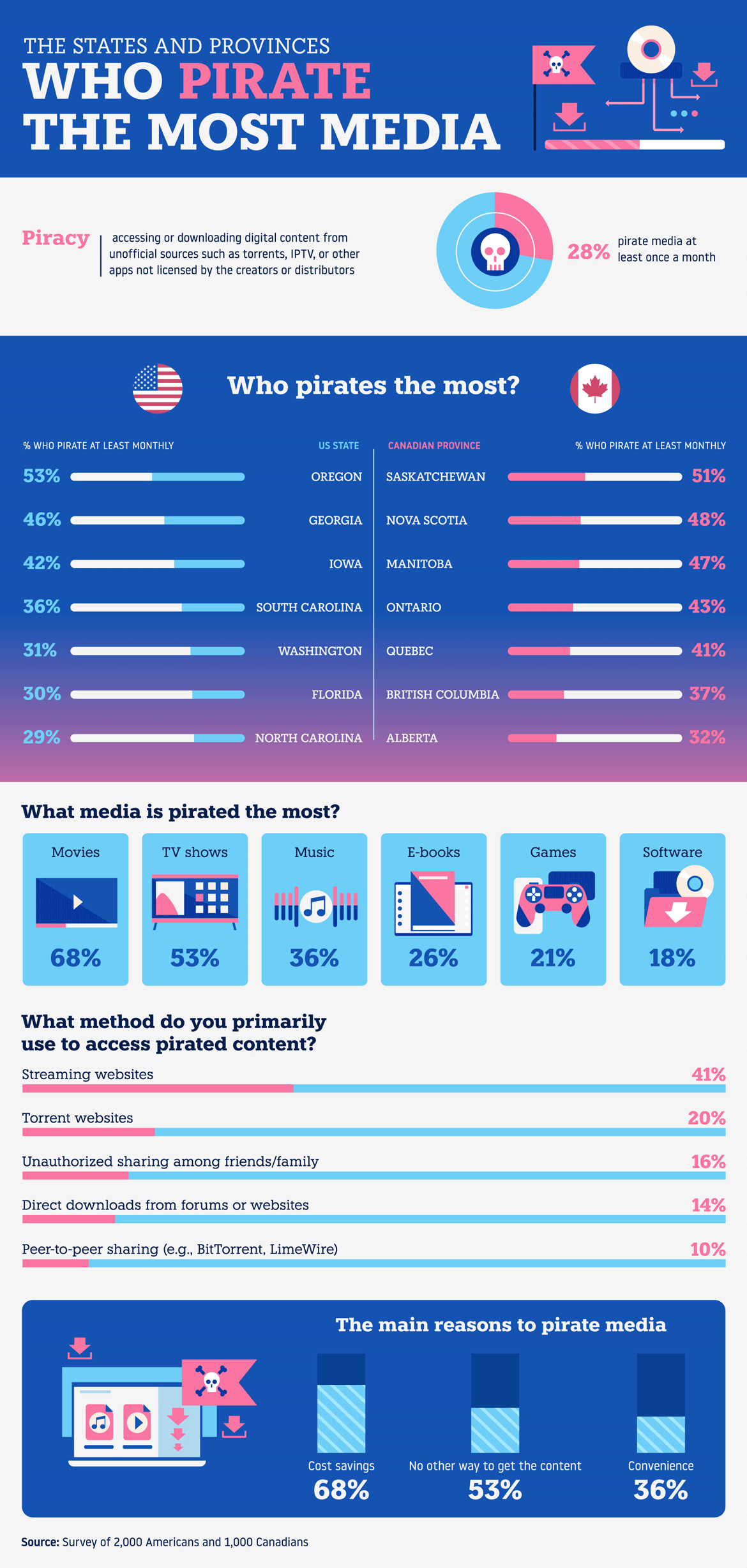
In an era where digital content is more accessible than ever, the persistent issue of media piracy remains a challenge across the United States and Canada. This trend not only affects the economics of media production, but also shapes how content is distributed and consumed – and based on the data, this trend isn’t going anywhere.
For the purposes of this article, we are defining piracy as accessing or downloading digital content from unofficial sources such as torrents, IPTV, or other apps not licensed by the creators or distributors.
Key Takeaways:
- About 28% of respondents engage in pirating media at least once a month.
- Oregon leads the entire pack with 53% saying they pirate monthly, with the Canadian province of Saskatchewan not far behind at 51%.
- The most pirated types of media are movies (68%), followed by TV shows (53%), and music (36%).
- A majority (57%) believe that digital piracy negatively impacts content creators and the industry, while 37% think it has a neutral impact – and only 6% see it as positive.
Why It Matters:
- Issues like cost and accessibility underscore the need for the media industry to adapt by providing more affordable and accessible legal content options.
- This change could help mitigate the economic losses faced by content creators and distributors due to piracy.
No matter what side you’re on, one thing is for certain: a wide-scale shift needs to happen in order to reduce the prevalence of piracy and make it both affordable for consumers and lucrative for the artists behind the entertainment we love to consume.

Regional Hotspots for Media Piracy
In the United States, Oregon leads with a surprising 53% of respondents admitting to pirating media at least monthly, closely followed by Georgia at 46% and Iowa at 42%. On the Canadian front, Saskatchewan nearly mirrors Oregon with 51%, while Nova Scotia and Manitoba follow closely at 48% and 47%. Such high percentages for both the US and Canada suggest a mutual accessibility issue influencing these behaviors, whether it be to stable Wi-Fi or, quite simply, the money to pay for (multiple) streaming services.
That said, even in more densely populated regions like Ontario and Quebec, piracy rates are still quite high (43% and 41%). This indicates that in areas with presumably better access to quality internet, piracy remains a preferred avenue across the board. So what kinds of media are people pirating?
What Media is Pirated the Most?
The types of media pirated highlight consumer preferences and potential gaps in what is readily available through legal means. Not surprisingly, movies top the list, with 68% of “pirates” choosing them over other forms of media. With theater movie tickets costing anywhere from $10 to $20 depending on where you’re located, it’s safe to say cost is a major reason people are opting to pirate their Friday night film, rather than see it on the big screen.
The serialized nature of television shows – and the fact that people have to subscribe to multiple streaming platforms just to catch up with their favorite series – is probably why 53% of people choose piracy when it comes to TV. Music, even though it’s easier to stream legally than ever before, is still pirated by 36% of respondents, followed by e-books, games, and software at 26%, 21%, and 18%, respectively.
Methods of Accessing Pirated Content
Streaming websites are the most common method for accessing pirated content, used by 41% of the participants. This method’s popularity underscores the shift towards more user-friendly and less technically demanding forms of piracy such as torrent websites, which require a bit of savvy knowledge, rank second at 20%.
The data also points to the significance of social networks in piracy, with 16% using unauthorized sharing among friends and family (which Netflix especially has since tried to combat). It’s likely that this method might be viewed as less risky or more ethical among users, with most viewing it as “sharing” (and caring) rather than stealing.
Why Do People Pirate Media?
In a world where a cup of coffee costs upwards of five bucks, a not-so-shocking 68% of respondents cite cost savings as the primary reason. Pricing strategies and styles of obtaining legal media is no doubt excluding these potential customers, who feel services and platforms are gouging for profit – then turn to piracy as a more accessible (and affordable) alternative.
With 45% saying they resort to piracy because they feel there is no other way to obtain the content, regional availability issues and delays or differences in content release are likely significant drivers for both the US and Canada.
Perhaps the most telling number is that 37% of users find pirating more convenient, plain and simple. Even though most streaming services are fairly straightforward to use, this suggests that the legal user experience with them needs to be revamped to compete with pirated alternatives.
The Ethics of Pirating Content
While an overwhelming majority – 89% – say they are aware of the legal and ethical implications associated with accessing pirated content, 94% say they’ve never been threatened with legal action. The question then becomes, if you most likely won’t get caught pirating your favorite media, why stop?
Over half of those surveyed (57%) believe that digital piracy negatively affects content creators, 37% believe it has a neutral effect, and only 6% believe it’s positive. Unfortunately, only 18% of those who pirate have been discouraged from accessing pirated content because of their increased awareness of the impact on creators – signaling a large divide in how people think about the differences between stealing, sharing, and supporting.
Streaming Forward
The persistence of media piracy in North America represents a complex interplay between consumer behavior, technological access, and the perceived value of content. Even in diverse markets, high rates of piracy are a clear indicator of broader systemic issues, pointing to the very real inadequacies of current legal streaming services and platforms in meeting consumer needs.
So how can these issues be addressed moving forward? Media companies might consider enhancing the convenience of their platforms through a combination effort or improving (perhaps offline) accessibility. As 69% of respondents believe a shift in the affordable access of legal content would be the best approach, finding flexible and fair pricing for consumers in order to protect the artists behind the scenes rather than simply aim for profit seems to be an inkling toward an answer.
Sure, at the end of a long day we’d all just like to Netflix and chill, but until the price tag and accessibility improves for most streaming services, piracy will likely be a favored alternative for a significant portion of the population, undoubtedly shaping the future landscape of media consumption.
Methodology
To compile this data, Bestontariocasinosites.ca conducted a study in April 2024 among 2,000 Americans and 1,000 Canadians. The median age was 36, with 54% identifying as women, 43% as men, and 3% as non-binary.
